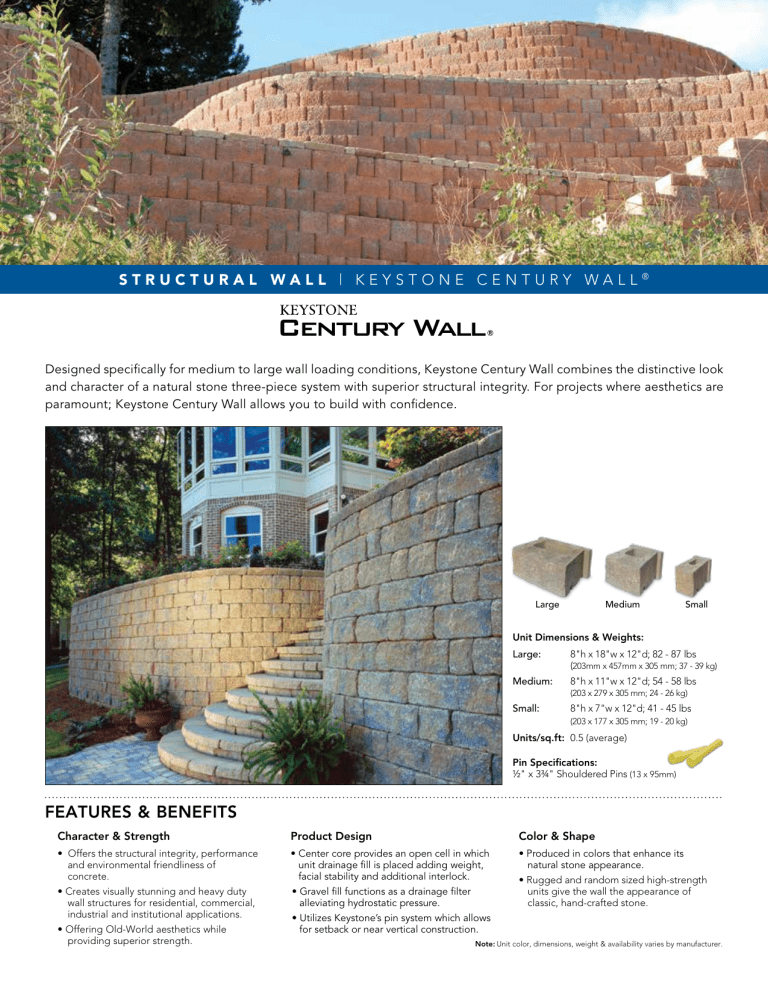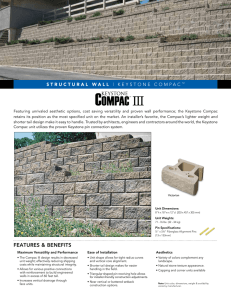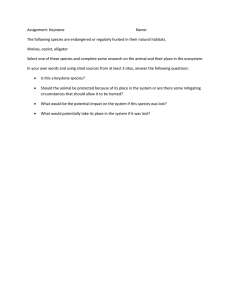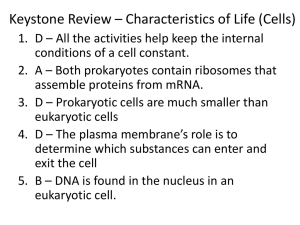Keystone Century Wall Spec Sheet PDF
advertisement

STRUCTURAL WALL | KEYSTONE CENTURY WALL® Designed specifically for medium to large wall loading conditions, Keystone Century Wall combines the distinctive look and character of a natural stone three-piece system with superior structural integrity. For projects where aesthetics are KEYSTONE paramount; Keystone Century Wall allows you to build with confidence. Century Wall ® Large KEYSTONE Century Wall Medium Small Unit Dimensions & Weights: ® ® Large: 8"h x 18"w x 12"d; 82 - 87 lbs (203mm x 457mm x 305 mm; 37 - 39 kg) Medium: 8"h x 11"w x 12"d; 54 - 58 lbs (203 x 279 x 305 mm; 24 - 26 kg) Small: 8"h x 7"w x 12"d; 41 - 45 lbs (203 x 177 x 305 mm; 19 - 20 kg) Units/sq.ft: 0.5 (average) Pin Specifications: ½" x 3¾" Shouldered Pins (13 x 95mm) FEATURES & BENEFITS Character & Strength Product Design Color & Shape • Offers the structural integrity, performance and environmental friendliness of concrete. • Center core provides an open cell in which unit drainage fill is placed adding weight, facial stability and additional interlock. • Produced in colors that enhance its natural stone appearance. • Creates visually stunning and heavy duty wall structures for residential, commercial, industrial and institutional applications. • Gravel fill functions as a drainage filter alleviating hydrostatic pressure. • Offering Old-World aesthetics while providing superior strength. • Rugged and random sized high-strength units give the wall the appearance of classic, hand-crafted stone. • Utilizes Keystone’s pin system which allows for setback or near vertical construction. Note: Unit color, dimensions, weight & availability varies by manufacturer. STRUCTURAL WALL | KEYSTONE CENTURY WALL® INSTALLATION INSTRUCTIONS 1. Prepare Base Leveling Pad After selecting the location and length of the wall, excavate the base trench to the KEYSTONE designed width and depth. Remove all surface vegetation and debris. Do not use this material as backfill. Start the leveling pad at the lowest elevation along wall alignment. Prepare the leveling pad base with 16 inches (400mm) of well-compacted granular fill (gravel, road base, or 1/2-inch to 3/4-inch (10 - 20mm) crushed stone). At required elevation changes in the leveling pad, step up in 8-inch (200mm) increments. Compact to 95% Standard Proctor or greater. Do not use PEA GRAVEL or SAND for leveling pad. 2. Install the Base Course Place the first course of units end to end (with front corners touching) on the prepared base. The surface of the unit with the long groove (receiving channel) near the front face of the unit should be placed down and the open pin holes should face up, as shown. For accurate and acceptable KEYSTONE results, make sure each unit is level - side to side and front to back. For alignment of straight walls, use a string line positioned along the unit pin holes for accuracy. Minimum embedment of base course is 8" (200mm) below grade. Century Wall ® 4. Install Fill & Compaction Century Wall ® ® Note: Do not run heavy (ride-on) compaction equipment within 3' (1m) of back of wall. Do not use PEA GRAVEL or SAND for drainage fill. Place the next course of Keystone Century Wall units over the fiberglass pins, fitting the pins into the long receiving channel recess in the units above. Push/pull the Century Wall units toward the face of the wall until the channel makes full contact with the pins. Each course should be built in a random arrangement with the only rule of thumb being to avoid vertical joint alignment. (i.e. stack bonding) 5. Install Additional Courses Place the shouldered fiberglass pins into the appropriate holes to achieve the desired setback position of the Keystone Century Wall units. Place pins in the front hole(s) for near vertical alignment. Place pins in the rear holes for an 8° setback per course. Clean off the last course of Keystone Century Wall in preparation for the cap or coping to finalize the wall. With units dry and clean, use a construction adhesive for a mechanical bond. Install capping units, architectural precast concrete, or cut stone as a coping element. Cap may be flush or overhanging as required by aesthetics and design. NOTE: The large unit has an “optional” pin hole to ensure small units above do not slip between pins. 3. Insert Fiberglass Pins Once the pins have been installed, provide ½" to ¾" (10-20mm) crushed stone drainage fill behind the units to a minimum distance behind the tail of 1' (300mm). Fill all open spaces between units and open cavities/cores with the same drainage material. Proceed to place backfill soil in maximum 8" (200mm) layers and compact to 95% Standard Proctor with the appropriate compaction equipment. 6. Capping the Wall Keystone Retaining Wall Systems LLC • A Contech Company 4444 West 78th Street • Minneapolis, MN 55435 (952) 897-1040 • www.keystonewalls.com ©2015 Keystone Retaining Wall Systems LLC




